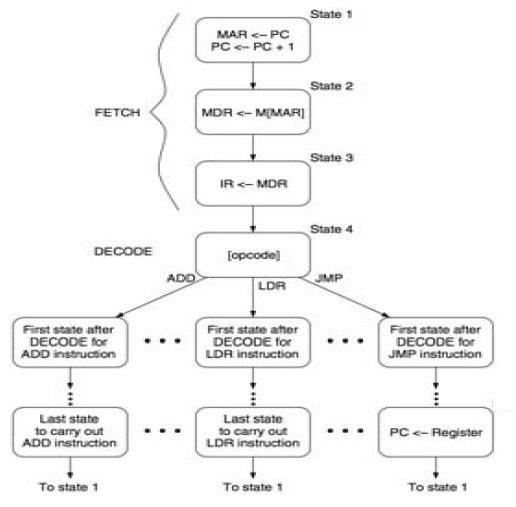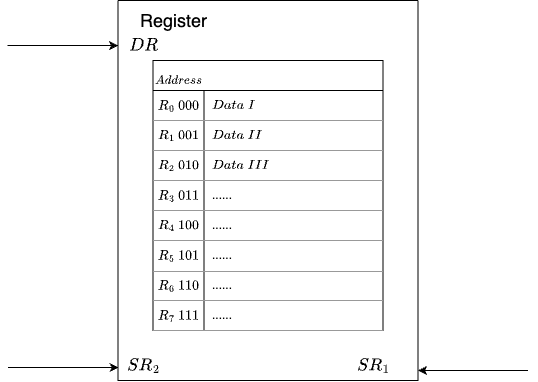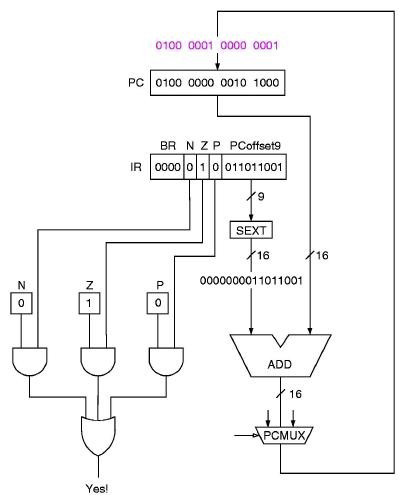Title: "[[ISA]]"
Author:
- AllenYGY
status: DONE
tags:
- NOTE
- CO
- Lec9
created: 2023-11-20T21:25
updated: 2024-05-31T01:01- ISA specifies what hardware does, but not how
- ISA defines the instruction code
- Microarchitecture specifies how it does it
- Microarchitecture determine how it work it

- Microarchitecture determine how it work it
The ISA specifies all the information about the computer that the software has to know.
- Memory
- Address space (how many locations?)
- Addressability (word or byte, word size)
- Registers
- Number (how many?)
- Type
- Instructions
- Operations
- Data types
- Addressing modes
Lc-3
- Lc-3 is a finite state machine

Lc-3 Memory Organization
- Address space
- means: there are
- means: there are
- Addressability
- Each block store 16-bit instruction
- Each block represent by a Hexadecimal code
- x0000
- x0001
- ....
- Address 逐行递增
- Each block represent by a Hexadecimal code
- Memory is store element
- Basic Operations
- LOAD
- read a value from a memory location
- STORE
- write a value to a memory location

- LOAD
Registers
-
features:
Special storaqge devices that are inside the GPU.
Fast to access 1 clock cycle
General Purpose Register GPR: accessible instructions -
Register is store element
- Achieved by D filp-flop
-
Register File
- 8 GPRs
- Each register represent by 3 bit to record its address
- 000
- 001
- 010
- ...
- 110
- 111
- 000
- Each register represent by 3 bit to record its address
- Source Register 1
- Source Register 2
- Destination Register
- 8 GPRs
-
Other special purpose registers:
- MAR,MDR
- PC,IR
- Condition codes: P,Z,N
- KBDR,KBSR,DDR,DSR

Instruction
- Opcode What the instruction does
- Operands What the operation acts on
In Lc-3
- 4 bits opcode (15)
- 2 Sources and 1 destination

Opcodes & Operations
Opcodes
Operate instructions Manipulate data directly
-
'Immediate' addressing mode
-
ADD 0001
-
AND 0101
---- --- --- --- ---
ADD DST SR1 000 SR2
0001 xxx xxx 000 xxx
---- --- --- --- ---
AND DST SR1 000 SR2
0001 xxx xxx 000 xxx
When string bit is 0 the addressing mode is "register mode"
Otherwise is "immediate mode"
---- --- --- - -----
ADD DST SR1 1 Imm5
0001 xxx xxx 1 Imm5
---- --- --- - -----
AND DST SR1 1 Imm5
0001 xxx xxx 1 Imm5
Imm5 is a const integer and imm5 will be extend to 16 bits when it be calcuted.
- subtract
- 2's complement
- OR
- Set Zero
- AND 0000 0000 0000 0000

- NOT 1001 Register Addressing mode
---- --- --- -------
NOT DST SRC 111111
1001 Reg Reg 111111
Data Movement instructions Move data between memory and registers(CPU)
-
Load read data from memory to register
- LD 0010 direct mode
- LDI 1010 base+offset mode
- LDR 0110 indirect mode
-
Store write data from register to memory
- ST 0011 direct mode
- STI 1011 base+offset mode
- STR 0111 indirect mode
-
Load effectively address compute address
- LEA 1110 immediate mode - does not access memory
---- --- ----------
LEA DR/SR addr.gen.bits
1110 DR/SR addr.gen.bits

Control instructions Change the sequence of instruction execution
- BR 0000
- JMP/RET 1100
- JSR/JSSR 0100
- RTI 0111
- TRAP 1111
Data Types
- 2's complement integers
Condition Codes
- 3 single bit registers (set to 1 or cleared to 0)
- N: when value written was negative
- Z: when value written was zero
- P: when value written was positive
- Affected each time any register is written
- Condition codes are read by conditional branch instructions
Addressing Modes
5 addressing modes
- Explicitly in the instruction itself 立即寻址
- In register 寄存器寻址
- In memory 内存寻址
- Pc-relative mode:
- Base+offset mode:
- Indirect mode: the address of a location that contains the address of the operand (indirect)
- Pc-relative mode:
PC-Relative Mode Direct mode 直接寻址
- LD
- opcode 0010
- effective address=(PC)+SEXT(IR[8:0])
---- --- ---------
LD Dst
0010 Reg

- ST
- Opcode 0011
- effective address=(PC)+SEXT(IR[8:0])
---- --- ----------
ST Dst
0011 Reg
- offset 9 bits
operand must be within 256 locations of the instruction
Base+Offset Mode
- LDR
- opcode 0110
- effective address = (BaseRegister)+offset
---- --- --- ------
LDR Dst BaseR offset
0110 Reg Reg
- offset 6 bits
Base+offset can address any location in memory

- STR
- opcode 0111
- effective address = (BaseRegister)+offset
---- --- --- ------
STR Dst BaseR offset
0111 Reg Reg
Indirect Addressing Mode
-
An address is first formed exactly the same way as with LD and ST
-
This address contains the address of the operand.
-
Just like base+offset, indirect mode can also address any location in the memory.
-
Memory has to be accessed twice in order to get the address of the operand
-
LDI
- opcode 1010
- pointer address = (PC) + SEXT(IR[8:0])
- effective address = Mem[(PC)+SEXT(IR[8:0])]
---- --- ---------
LDI Dst Addr.Gen.bits
1010 Reg Addr.Gen.bits

- STI
- opcode 1011
- pointer address = (PC) + SEXT(IR[8:0])
- effective address = Mem[(PC)+SEXT(IR[8:0])]
Control Instructions
-
Lc-3 has 3 conditional code registers
- N negative
- Z zero
- P positive
-
set by any instruction that stores a value to a register
- ADD,AND,NOT,LD,LDR,LDI,LEA
-
BR
- opcode 0000
---- --- ---------
BR NZP offset
0000 NZP offset
when condition is satisfied PC=PC+offset

- JMP jump OR goto
- opcode 1100
---- --- --- ------
JMP 000 BaseR 000000
1100 000 Reg 000000
unconditional jump
PC jump to Reg
- TRAP Invoke a system routine
- opcode 1111
---- ---- --------
TRAP 0000 trapvec
1111 0000
PC is set to the instruction TRAP